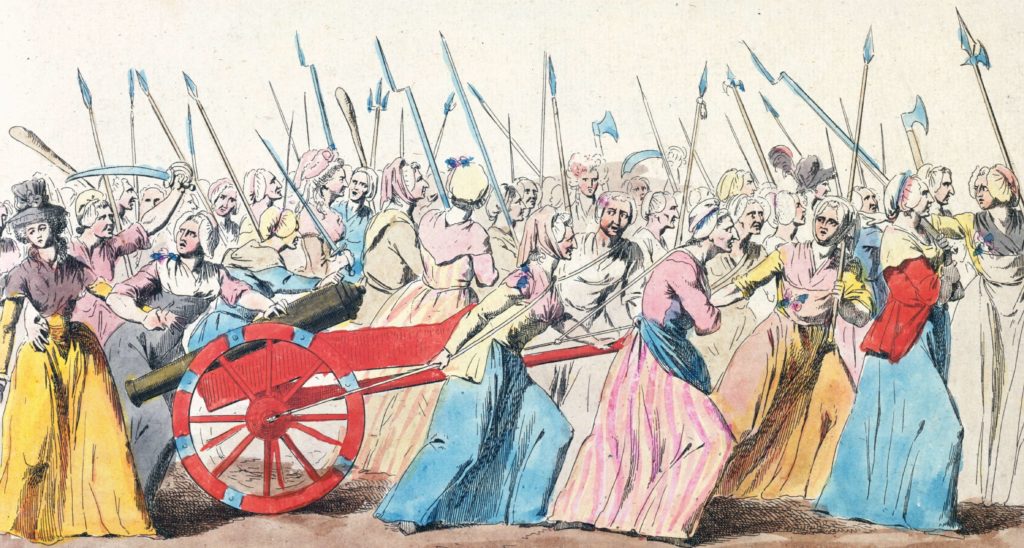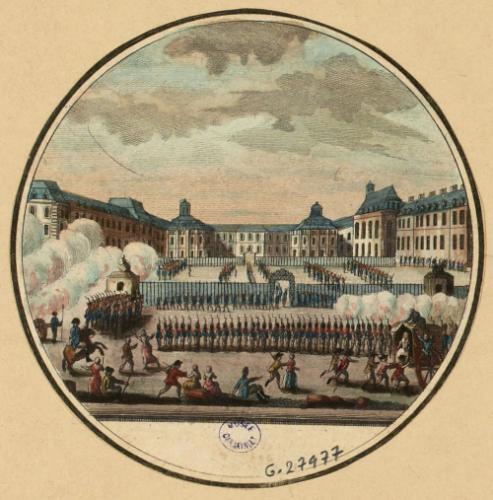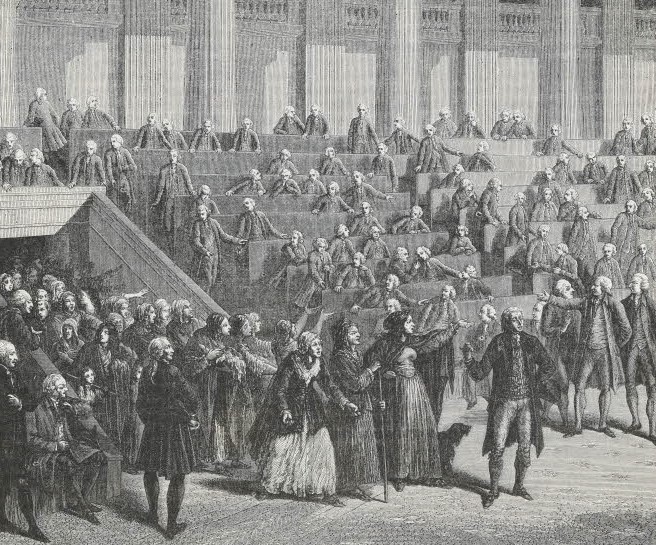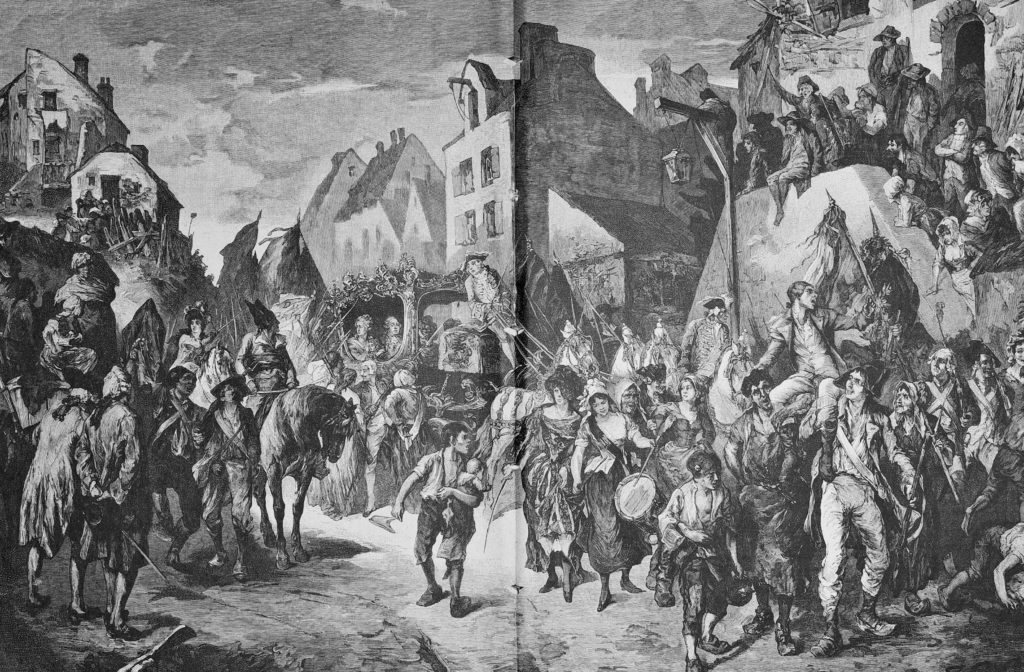Take yourself back to the markets of Les Halles, Paris, exactly 231 years ago, and join the women who will march on Versailles. These women were wives and mothers and tired of endlessly waiting in line for bread for their families. They took whatever weapon they could get their hands on, found a spare cannon or two, and marched all the way from Paris to Versailles. Why? To bring Louis XVI, the King, to Paris so that he could fix the deplorable mess France found itself in.
It was October 5, 1789. The Bastille had been attacked and ‘liberated’ by an angry mob not long before, on 14 July (See related post: Bastille Day in France). The French Revolution was still in its infancy, but it had begun.
Why was there a revolution?
Leading up the revolution, France was riddled with debt, poverty and social unrest. It was ruled according to the Ancien Regime: the First Estate was the clergy of the church, the Second the nobility, and the Third, certainly the most numerous, was the bourgeoisie and the peasantry, who bore the brunt of growing the nation’s food and providing its revenue. Unrest had been fermenting for a long time, with poor harvests and rising bread prices. In July 1788 an enormous hailstorm damaged much of the crops across parts of France, followed by a harsh winter. Frosts killed vines and olive trees, the rivers froze, and poor farm animals struggled to survive. Riots against the hoarding of grain were common, and as the weather warmed the bread prices rose even further. Much of the population of France lived in abject poverty.
But the French Revolution was not really about hungry peasants rioting in the streets over the price of bread. Louis XVI had called for a meeting of the Estates-General, which meant members of the clergy, the nobility and deputies from the provinces representing the third estate, came together in Versailles in May 1789 (Related post: A Visit to Versailles)
After much discussion and deliberation which really went nowhere, the third estate broke away and declared themselves to be a National Assembly. But what they needed was for Louis XVI to agree to their demands for a constitution and his support for their newly written Declaration of the Rights of Man and Citizens.
Even a few months after the storming of the Bastille, not much changed for the people of Paris. The price of bread had gone down somewhat because of a good harvest, but with the summer months many rivers had dried up and therefore the mills were unable to grind the grain.
Conspiracy theories were ripe: the greedy merchants were inflating prices; the bishops were hoarding the grain; the king had ordered that the people of France starve as a punishment for the National Assembly,

The women of Paris had had enough of waiting in line for hours for bread to feed their families.
‘To Versailles!’

“The insurrection broke out in a manner at once violent and resistless; the absolute want of bread was the signal for it. A young woman entering a guard-house seized a drum, and ran along the streets beating it, and crying, Bread! Bread! She was soon surrounded by a crowd of women. This mob advanced toward the Hotel-de-Ville, thickening as it went along: it forced the Horse-guard, which was at the gates of the commune, penetrated to the interior, and demanded bread and arms; it broke open the gates, seized the arms, sounded the tocsin (alarm bell), and prepared to march on Versailles. Presently, the people in a body, raised the same shout, and the cry “To Versailles!’ became general.”
M. Mignet, History of the French Revolution, Volume 1, 1826
Why did the women march on Versailles? The palace of Versailles was the royal seat of power, and it was where Louis XVI, Marie Antoinette and their two children were in residence (Sadly for the royal family, the Dauphin Louis Joseph had died several months before). The newly formed National Assembly were also in Versailles.
So once the call to march on the royal palace had been heard, up to ten thousand women joined in and walked the 21 kilometres to Versailles.
“Now that bread cannot be had in Paris, let us go to Versailles and demand it there; once we have the King, Queen, and Dauphin in the midst of us, they will be obliged to feed us;” we will bring back “the Baker, the Bakeress, and the Baker’s boy.”
“We shall bring back the Queen’s head on the end of a pike!”.
“Let us cut her throat, and make cockades of her entrails!”
Hippolyte Taine, The Revolution, 1878
The queen, Marie Antoinette, was not popular with the people of France. She was referred to as “Madame Deficit”, among other cruel nicknames, as it was believed her lavish spending had led to the country’s financial troubles (true, but she actually spent less than other members of the royal family).
The women were also furious over (erroneous, as we now know) reports there had been a banquet at the royal palace a few days earlier in which the king’s soldiers had trampled all over the newly created tricolour cockade. And to hold a sumptuous banquet, while they and their families starved, was completely outrageous.
The marching women arrived in Versailles in the early evening. It had been a rainy day, and they were drenched, hungry and exhausted.

Such things are seen only in France ; our women are brave, and make others so. The country of Joan of Arc, Joan of Montfort, and Joan Hachette, can quote a hundred heroines.
Jules Michelet, History of the French Revolution, 1847

They invaded the National Assembly and demanded bread. They also wanted punishment for the royal guardsmen who had insulted the national cockade.
A delegation of around six women was chosen to confront the King.
The young girl, Louison Chabry, had been charged to speak for the others; but her emotion was so great in the presence of the king, that she could only articulate “Bread!” and fell down in a swoon. The king, much affected, ordered her to be taken care of; and when, on departing, she wanted to kiss his hand, he embraced her like a father. She ran out a Royalist, and shouting ” Vive le Roi !
Jules Michelet, History of the French Revolution, 1847

The swooning notwithstanding, the women managed to gain the sympathy of Louis XVI and he promised to give them bread and grain to take back to Paris. He also agreed in principle to the demands of the National Assembly and to accept the Declaration of Rights.
Much later that night, about 20,000 National Guardsmen arrived in Versailles after a long march from Paris. Loyal to the Revolution, they were under the (reluctant) command of the Marquis de Lafayette, and had orders from the Parisian municipal government to formally request the King’s return to Paris.
Attack on the palace
Everything seemed to have calmed down by the next morning, until a small group forced their way into the Palace of Versailles. They were fired on by the royal bodyguards which enraged the mob waiting outside, who then stormed their way inside while brandishing their weapons. Two of the bodyguards were killed and their heads displayed victoriously on pikes.
The angry mob pounded furiously on the door of the queen’s apartments. Marie Antoinette had just enough time to gather her children and escape via an underground tunnel to the king’s room. There, with advisors, they listened to the roaring crowds outside demand they return with them to Paris.
Vive le king et la reine!
Whilst Louis XVI would be executed in a few years (see related post: Last words from the Guillotine), at the beginning of the Revolution there were no popular calls for an end to the French monarchy. So when Louis stepped out onto the balcony to appease the people, there were many cries of “Vivre le Roi!”, “Long live the King!”, and “To Paris!”. He agreed to go to Paris, as long as his family remained with him.

Marie-Antoinette’s reception when she emerged onto the balcony was not so polite, but according to eye-witnesses she gained the respect of the crowd by standing there, defenceless. Apparently calls of ‘Vive la reine’, long live the queen, were heard for the first time in a long time.
By early afternoon the royal family were ready to leave Versailles.
off to Paris we go
The crowds had swelled, and it’s estimated around 60,000 people were in the procession from Versailles to Paris. Alongside the many carriages were wagons full of flour from the palace stores, as Louis XVI had promised.

After an excruciatingly slow nine hours, the journey was over. Louis XVI, Marie Antoinette, their children and other family members were installed in the Tuileries Palace, on the Seine river, in Paris. They would never return to Versailles again.
The women’s march on Versailles was not as spontaneous as some historians would have us believe. There had been many calls in the preceding weeks, even months, for the King to return to Paris to deal with the escalating crises. Some believe Louis Philippe II, Duke of Orléans, and a cousin to the king, was quietly orchestrating events so as to further the anger of the people, after which he hoped to be made king of a new constitutional monarchy.
importance of the women’s march on versailles
What is clear though, is that many of the thousands of women marched without political goals; they wanted food for their families and a leader who would provide for them. While the history of the French Revolution is largely told by and about men, the women of France did more than their share in bringing about changes that would reverberate around the world.
what happened to the palace of Versailles?




Someone asked Napoleon what he would have done if her were in Louis XVI’s position when the women of Paris marched on Versailles. He responded that he would have used canon to blast them back to Paris. A shocking comment coming from the great revolutionary general? Not really. Napoleon was an artillery expert who understood the use of power and he was decisive in making decisions.
Louis XVI genuinely wanted to be loved the father of his people and was indecisive in making decisions. But by giving into the mob he created a power vacuum and in the end paid for it with his head and the heads of millions of other in the endless wars that followed. Napoleon would not have countenanced being dragged to Paris by a mob displaying the heads and genitals cut from the bodies two loyal bodyguards who died protecting the Queen.